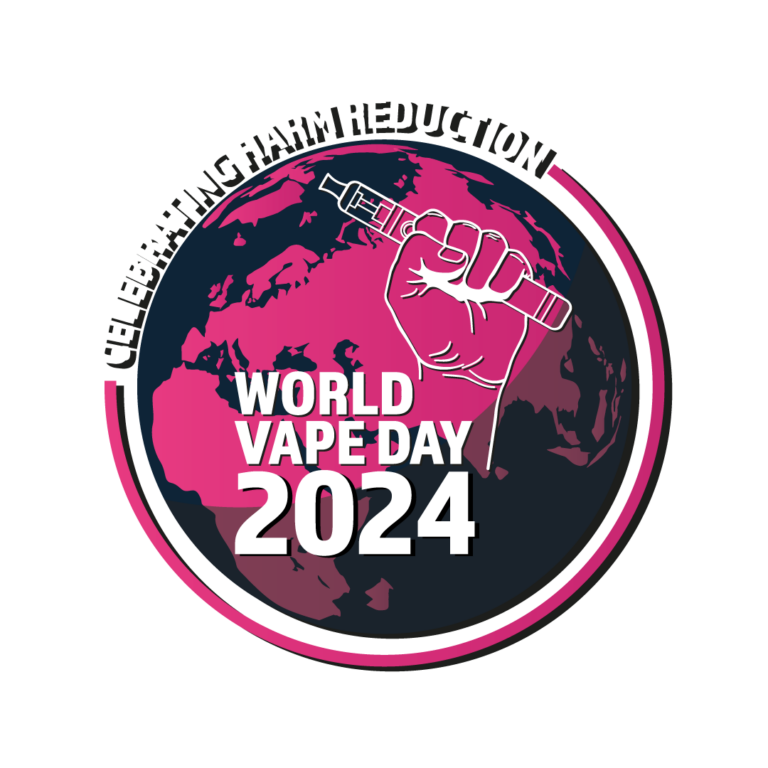
It’s on May 30th, 2024
On Thursday, May 30, the vaping community worldwide will be celebrating harm reduction efforts around the globe. The choice of date is not coincidental and falls just one day before the World No Tobacco Day proclaimed by the WHO: precisely to showcase that vaping and other harm reduction tools are one of the most efficient ways to help smokers quit.
This year, WVD will focus on the theme of the “Misperception Epidemic” We’re here to expose how widespread misinformation is blocking smokers from switching to safer alternatives. By tackling misconceptions head-on, we want to empower individuals with evidence-based knowledge and spark meaningful conversations about how vaping can fast-track us to a smoke-free world.
Realtà: lo svapo è il 95% meno dannoso del fumo.
Vaping is often mistakenly believed to be as harmful as smoking. However, while vaping is not completely risk-free, it poses significantly lower risks than smoking – 95% lower according to Public Health England.
Combustion cigarettes release thousands of chemicals, including up to 70 carcinogens and other toxins like tar and carbon monoxide. Due to the lack of combustion and the differences in ingredients, most of these harmful chemicals are not present in the vapour of electronic cigarettes, making nicotine consumption much less harmful and lowering the risks of smoking-induced illnesses like cancer, lung disease, heart disease, and stroke.
Reality: Vaping has already helped millions of smokers to quit.
Evidence has shown that vaping is one of the most effective ways to quit smoking, and more effective than traditional nicotine replacement therapies like nicotine patches or gums. They can even help reduce nicotine dependence thanks to the possibility to adjust nicotine concentration levels. Smokers find it an attractive alternative because of the similar action of putting a cigarette in the mouth and the similar sensation of feeling the smoke in the throat.
Reality: Nicotine is not the problem.
Smoking-related illnesses and deaths are caused by the harmful ingredients in traditional cigarettes and the toxins liberated during combustion, not by nicotine.
Nicotine is an addictive substance, but it is relatively harmless to health and does not increase the risks of severe illness or mortality. As we know, nicotine is not a problem in conventional nicotine replacement therapies. Therefore it cannot be a bigger problem in vaping.
Reality: Vaping is not related to EVALI or popcorn lung.
EVALI is linked to illicit THC vape products containing vitamin E acetate, while popcorn lung is caused by diacetyl. Both substances are banned as e-liquid ingredients and cannot be found in legal vaping products.
Reality: Vape aerosol is different from cigarettes smoke and is harmless to those around you.
E-cigarette vapour and cigarette smoke are considerably different. Smoke results from cigarette combustion, which releases thousands of harmful chemicals, some of them carcinogenic, while vape aerosol results from the heating of e-liquids, which contain common food ingredients that are safe to ingest.
Research shows that those near a vaper inhale 100 times less nicotine than a passive smoker, ruling out the existence of the passive vaper.
Realtà: lo svapo è una via d'uscita dal fumo.
In molti paesi, i fumatori giornalieri sono ai livelli più bassi registrati. Lo svapo è stato accreditato per aver aiutato le persone a smettere di fumare e gli studi dimostrano che è due volte più efficace della terapia sostitutiva della nicotina. L'affermazione del gateway non è supportata da prove, poiché solo l'1,5% dei non fumatori [nel Regno Unito] attualmente svapa e i tassi di fumo continuano a diminuire. La rispettata ONG sanitaria Cochrane e varie agenzie sanitarie raccomandano lo svapo come mezzo per smettere di fumare grazie alla sua efficacia.
Realtà: più di due terzi dei vapers adulti usano aromi diversi dal tabacco.
I critici che cercano di vietare i sapori di svapo affermano che sono usati solo dai minori e fungono da porta d'accesso al fumo. Tuttavia, gli aromi sono progettati principalmente per consentire agli adulti di smettere di fumare mascherando il gusto del tabacco. Infatti, oltre i due terzi dei vapers usano regolarmente aromi non al tabacco. Gli aromi non solo aiutano i fumatori a smettere, ma riducono anche la probabilità di ricaduta. La Yale School of Public Health riporta che i dispositivi di svapo aromatizzati aumentano le probabilità di smettere di fumare tra gli adulti del 230%. Vietare i sapori potrebbe portare la metà dei vapers a tornare a fumare o al mercato nero.
Realtà: non ci sono prove di un effetto porta nei giovani al fumo. La maggior parte di loro prova a svapare dopo aver già iniziato a fumare.
La limitazione dello svapo basata sull'affermazione di un'epidemia giovanile non è supportata da prove e nella maggior parte dei paesi è già illegale per i minorenni svapare. Gli studi dimostrano che il fumo giovanile è diminuito negli Stati Uniti, in Germania e nel Regno Unito da quando l'uso di sigarette elettroniche ha iniziato ad aumentare. Fattori ambientali come l'abitudine al fumo dei genitori e la predisposizione genetica hanno maggiori probabilità di portare i bambini a svapare o fumare. Le prove suggeriscono che lo svapo può distogliere i giovani ad alto rischio dal fumo e la maggior parte degli adolescenti prova a svapare dopo aver già iniziato a fumare. Una revisione di quindici studi nel 2019 non ha trovato prove di un vero effetto gateway nei giovani.
Realtà: tasse di svapo più elevate hanno un impatto negativo sulla salute pubblica.
Gli aumenti delle tasse sui prodotti da svapo portano i vapers a passare alle sigarette, soprattutto tra i giovani adulti. Questo, a sua volta, danneggia la salute pubblica. Si raccomanda una tassazione basata sul rischio, con tasse più basse sui prodotti meno nocivi, per incoraggiare i fumatori a cambiare. Limitare l'accesso ai prodotti da svapo tramite prezzi elevati ha conseguenze indesiderate, poiché gli utenti si rivolgono al mercato nero o fumano. I prodotti del mercato nero non regolamentati sono più dannosi, in quanto non rispettano le norme di sicurezza, rappresentando un rischio per gli utenti e la salute pubblica.
Realtà: oltre 100 organizzazioni concordano sul fatto che lo svapo è probabilmente meno dannoso del fumo sulla base di principi scientifici, nonostante i rischi a lungo termine sconosciuti.



Help us spread the word!
World Vape Day is right around the corner! It’s a joyful day when we celebrate the lives saved by this innovative technology. To help you invite your friends and your community, we prepared promo materials – and they are free to use and publish for everyone!
Our goal is to raise awareness about the Swedish success in tobacco harm reduction and encourage Swedes to celebrate their achievement. We will spread Sweden’s success story on the EU level, among EU member states and an international audience through political outreach, but also in the media and the vaping community. We will run digital and grassroots events, and help vapers raise their voice.
Let’s take action and beat smoking rates like the Swedes. By embracing harm reduction, we can achieve smoke-free societies and improve public health for all.
© 2024 – World Vapers’ Alliance. All rights reserved.